Appropriate Technology
Appropriate technology is a movement focusing on the use of small-scale, energy efficient, environmentally sustainable, people-centered, and locally controlled technology.
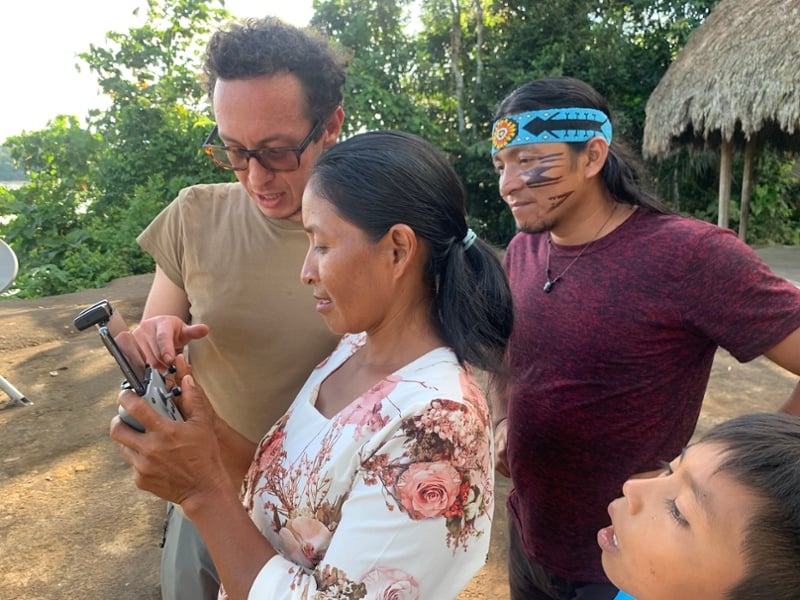
Joel Koupermann training Santa Tentets and Nantu Canelos of the Sharamentsa community in the Amazon on how to use drone technology to monitor their territoriy.
What Is Appropriate Technology?
Appropriate technology is an ideological movement that involves small-scale, labor-intensive, energy efficient, environmentally sound, people-centered, and locally controlled projects.
Appropriate technology projects:
- Use local materials and people-power often taking the form of “earth building”
- Are culturally sensitive/relevant
- Are used by locals to fill a self-identified need
In addition, this method uses open-source knowledge, meaning there must be transparency in the process and outcome, and this information must be shared to ensure it is replicable.
An Alternative Form of Economic Development
Appropriate technology is a critique to GDP-focused measures of growth and is meant to address four major problems GDP-growth does not cover: extreme poverty, starvation, unemployment, and urban migration.
Commonly discussed as a form of economic development, this type of sustainable technology is an alternative to technology transfer from wealthier nations to less wealthy nations. This kind of technology transfer is often patronizing, with one party telling the other what to do and what they need, while appropriate technology compels authentic collaboration among all those who are involved.
Furthermore, this movement uses both hard and soft technologies. A hard technology is related to a certain type of goal and involves machinery, structures, and engineering methods. Soft technology creates behaviors that bring about change and involve human interactions and motivations.
Assessing Appropriate Technology
Many people and cultures around the world tend to assume that all technology is progress.
This often leaves out important externalities and side effects of the new technology and its development, such as environmental and social impacts. It's important to incorporate such considerations to better analyze whether new technologies are appropriate.
The History of Appropriate Technology
Mahatma Gandhi is thought of as the father of the movement, developing the concept of village-based technology, though there was no name for it at the time.
Economist Dr. Ernst Friedrick “Fritz” Schumacher coined the concept of appropriate technology in 1962, but called it intermediate technology.
A decline in the movement’s popularity is attributed to the growth in popularity of the “lassez-faire,” or free-market, view of economics.
Examples of Appropriate Technology in the Amazon
There are many examples of the use of appropriate technology in communities around the world.
The Achuar, an Indigenous nation in the Ecuadorian Amazon rainforest, use different kinds of appropriate technology in their communities to facilitate public health, communication, and transportation.
Composting Toilets
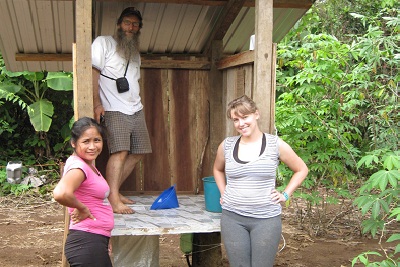
A composting toilet in the Amazon.
Composting toilets are dry-flush toilets whose decomposition process is faster than that of traditional wet toilets. They can use natural deodorizers and liquid absorbers such as peat moss. They are typically used in places without access to plumbing and water sanitation facilities, such as the Amazon rainforest, and are relatively simple to install and maintain.
The Achuar have only lived in settled communities since the late 1960s, and were semi-nomadic before. Thus, with the major lifestyle change came issues with water sanitation, which led to increasing rates of infant mortality. Composting toilets were a logical choice, for they would help them improve local sanitation issues without damaging their pristine environment. It was a choice geared towards preserving their traditional ways of life while improving their standards of living in a socially responsible manner. Their commitment to the health of their people and their natural environment has led to other positive health project choices as well.
iPads for Communication
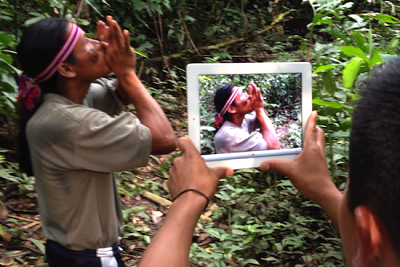
The Achuar making use of iPads to send messages to their distant neighbors.
The Achuar use iPads for communicating between their communities through video.
The interactive nature of the iPads allows for the Achuar to film and edit videos their own videos. Solar-powered chargers allow them to be sustainable and environmentally friendly.
Given the threat of new oil development on their ancestral land, the Achuar enthusiastically adopted the use of iPads to communicate ideas and information about preventing oil development on their territory. Since their remote communities do not have access to mail systems or the internet, the iPads have helped strengthen their national identity and cohesion as the Achuar people at an incredibly crucial time.
Solar-powered Canoes
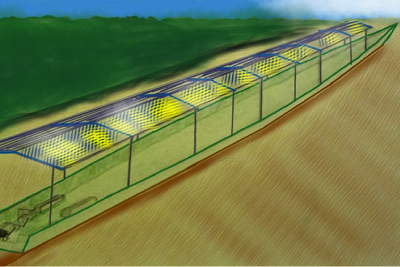
A sketch of the Achuar’s solar-powered canoe.
The Achuar needed an environmentally friendly way to travel through their rainforest home, and decided that solar-powered canoes would be a good option. To build a solar-powered canoe, solar panels are installed on the roof of the canoe, with charging batteries stored inside the body of the canoe, which powers the motor noiselessly.
The Achuar live in a pristine, bio-diverse region of the Amazon crisscrossed by rivers. Solar-powered canoes help them travel to distant communities without damaging or disturbing their natural environment. The noiseless motor does not disrupt their sensitive ecosystem.
These canoes meet the Achuar people’s needs for transport and a petroleum-free future, making solar energy an excellent sustainable development alternative. Solar-powered canoes and boats have a great potential to be replicated around the world.
Solar Water Pump
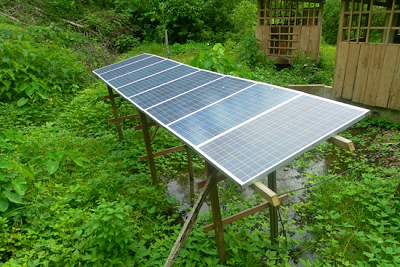
A solar panel which powers a water pump.
The goal of solar-powered water systems is to bring water to each family without complex plumbing systems, using solar powered pumps attached to a spigot for each family.
What Appropriate Technology Is Not
Oil Development
Oil development in the pristine Amazon rainforest is an example of a development project that is not appropriate technology. While the ILO Convention 169 requires informed, prior consent for any development projects on Indigenous land, that is often not the case. Often, the Indigenous people are informed when the project is already beginning, or are told false or misleading information. That in itself disqualifies it as appropriate technology
Another pillar of the movement is environmental soundness, which again disqualifies oil development in the Amazon. Oil projects have contaminated rivers and other water sources of the people, poisoning and killing plants, animals, and humans. Oil development projects are not only destructive, but large-scale, again disqualifying it as sustainable technology. They often employ non-local labor, and most all of the benefits are seen by outsiders as well, leaving the locals with the negative externalities. Thus, we can safely say that sustainable, eco-friendly alternatives that utilize local power and have local consent should be sought out instead of oil development projects.
Fracking
Fracking is a technology used to release natural gas from shale bedrocks. Fracking involves of pumping a high pressure liquid consisting of water and 590 different chemicals which create lots of cracks—and small earthquakes—in the rock to release the gas. The chemicals leach into drinking water sources and use seven million gallons of water per session, making it very wasteful and environmentally unfriendly.
Additionally, like oil development, fracking is not a small-scale project. Instead, it is large and incredibly destructive, inflicting harm on the communities surrounding the fracking site. Furthermore, many people oppose fracking and have protested it in their communities.
Incorporating Appropriate Technology into Your Life
Given the nature of our consumerism-driven global economy, there are many things which are frivolous and likely not appropriate technology. It is worthwhile for us to examine our own lives to determine what is appropriate and what is not.
Often, we bring technology into our lives or homes or offices because it’s “what you do,” or because we equate technology with progress. It can be useful to stop and ask ourselves, “What is most important to me in life? Does this technology help me achieve it? Does this technology create harm?”
You may also consider what are sustainable technologies for your community. For example, does your community have a dam? Did you consider the area that was flooded and the people who were displaced for its construction? Or the damage that could be caused if the levees broke?
What’s important is that we examine our common assumptions, become truly aware of what is going on around us, and create our world mindfully and intentionally.
Stay Connected to Our Work
Get a digest of Pachamama Alliance news, events, and resources in your inbox every other month, plus breaking news about our work.